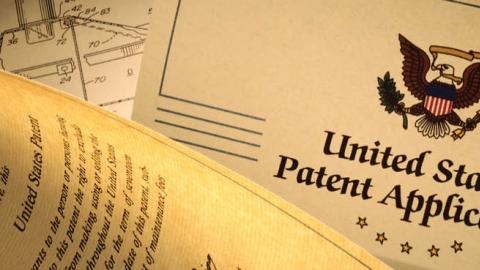A year ago, the Senate held three days of hearings with 45 witnesses on a legislative proposal that would have brought much-needed reform of 35 U.S.C. § 101. These extensive hearings on patent reform were unprecedented in recent times. They were a strong signal of a commitment by policymakers to abrogate the disastrous and destructive Alice-Mayo inquiry. Senators Thom Tillis (R-NC) and Christopher Coons (D-DE) promised quick action with a bill formally introduced by mid to late summer. A year later, there is no bill and the reform effort has stalled.
Silence is Consent
What happened? Notably, Big Tech refused to participate in the hearings. Senator Tillis explained in the second day of hearings that “we invited some of the large, high-tech companies to be present and they decided not to as individual companies and instead be represented by … the High Tech Inventors Alliance, and that’s okay, but … silence is consent. What we want here is people working out of the shadows collaboratively with the bill.” In his opening remarks on the third day of hearings, Senator Tillis stated again that “we did invite Google, Apple, Dell, Microsoft, and Oracle to testify,” and again noted that these companies declined to do so in lieu of a single witness from the High Tech Innovators Alliance (HTIA).
At the hearings, HTIA and other opponents of reform from policy organizations closely linked with HTIA members invoked the tread-worn narrative of abusive patent litigation by patent trolls. They argued they needed the Alice-Mayo inquiry to quickly and efficiently dismiss these patent troll lawsuits to avoid incurring unnecessary litigation expenses.
The patent troll narrative in the patent policy discussions in D.C. has worked well for Big Tech for more than a decade. The patent system has been substantially weakened over the past 15 years with a slew of court decisions, regulatory actions, and legislation that have mostly restricted or eliminated many patent rights. By itself, the Alice-Mayo inquiry has wrought legal uncertainty and unprecedented invalidations of patents or rejections of patent applications. The data confirms a loss of the longstanding competitive advantage of the gold-standard U.S. patent system in promoting innovation relative to Europe and China.
The Real Strategy
The simple fact, though, is that Big Tech is not truly concerned about patent litigation. Yes, there are some bad actors in the patent system, such as the notorious scammer MPHJ, just as there are in any field of law or other human endeavor. But rhetorical epithets and junk science statistics do not prove the patent system is “broken” or that patents impose a “ tax ” on innovation.
Big Tech’s goal is more strategic: a weakened patent system makes it possible for these companies to engage in what lawyers and policy wonks call “ efficient infringement. ” Everyone else calls it piracy. Invention theft has become more common because it’s now an easier and cheaper method for large, well-capitalized companies to simply take someone else’s technology than to invest the time, money, and resources in creating it themselves.
Piercing the veil of Big Tech’s self-serving policy rhetoric, the data confirms that they are not suffering from widespread “abusive litigation” by “patent trolls.” Big Tech companies are not now—nor were they ever—the victims of a massive wave of patent lawsuits, either before or after the Alice-Mayo inquiry was created by the Supreme Court. This is a policy canard.
In fact, the litigation trend for HTAI member companies is downward. Since 2010, HTAI companies have experienced approximately a one-half to one-quarter drop in lawsuits filed against them (with a significant number of the recent lawsuits filed by a single company):

One might still argue that approximately 150 patent infringement lawsuits filed per year against a handful of high-tech companies is a tremendous number of lawsuits. But the question is always: By what standard? Or, as economists put the point: As compared to what?
Making Assumptions
First, there’s a denominator problem. It is wrong to assume that all 150 lawsuits filed against HTAI companies are “abusive” (regardless of how this term is defined). Of course, HTAI member companies make this assumption, for obvious economic reasons. Policymakers should not accept Big Tech’s assertion that these are abusive lawsuits filed by patent trolls. When a company says, “Do no evil,” this does not mean it practices what it preaches.
The optimal number of lawsuits in any field of law is not zero. Disputes always occur, and these disputes sometime require resolution by the courts. This is as true today as it was in the 19th century, in which there were many more patent lawsuits by an order of magnitude than today.
Second, HTAI members represent large, multi-national companies with hundreds of billions in revenue, and this makes clear that these lawsuits are statistically insignificant. Normally, all companies see legal disputes increase as their businesses grow, including intellectual property disputes. Not so for HTIA members.
HTIA members have enjoyed phenomenal economic success in the past decade while patent infringement lawsuits have decreased over this same period. HTAI members had a combined market cap of $140,717,157.10 (millions) on December 31, 2010. Their combined market cap increased to $337,093,637.32 (millions) by December 31, 2019. This is a whopping 58.3% increase (this excludes Dell, which was a private company for a period from 2013 to 2018). Their combined revenues grew at an equally impressive rate. In 2013, HTAI members had a combined revenue of $574,435,112,000.00 and by 2019, it was $953,776,235,000.00—a 39.8% increase (again, this excludes Dell). These numbers have only increased during the COVID-19 pandemic, as Big Tech companies have had massive increases in profits if only because demand for uses of their services skyrocketed during the quarantines and shutdowns.
In sum, while patent lawsuits have dropped against Big Tech, their revenues have soared:

During this same time period, according to data from the AIPLA’s annual “Report of the Economic Survey ” and from Lex Machina, costs of patent litigation generally have dropped:

Even more important, damages awards on findings of infringements of valid patents have dropped significantly over this same time period (2011-2019), and while there has been a slow rise in recent years, they are still below the levels they were in 2011 or 2012:

In sum, the data paints a very different picture than that portrayed by HTAI member companies in their public statements and lobbying efforts. Instead of a never-ending tsunami of ongoing lawsuits brought by abusive “patent trolls” (defined broadly to encompass any patent owner, including even universities and inventors ), HTAI members have experienced a relative low number of total patent lawsuits, with decreasing overall costs and generally lower damages awards. (Data also confirms a significant drop in awards of injunctions for many patent owners, including for both manufacturers and licensors.) Concurrently, HTAI member companies have benefited from massive increases in both revenue and market capitalization.
Why then are HTAI member companies opposing reform of Section 101?
The Sonos Example
The answer to this question is found in the answer to the question, “Who benefits from a weakened patent system?” Sonos can answer this question. The innovative startup pioneered wireless speaker technology in 2005. In 2013, Sonos entered into a commercial relationship with Google and Google gained access to Sonos’ proprietary technology. Sonos then spent the ensuing years continually requesting that Google respect its intellectual property rights, especially after Google began competing with Sonos by selling its own wireless speakers, which incorporated Sonos’ technology and which were sold at lower prices than Sonos speakers. For years, Sonos insisted that Google enter into a license to use its technology. Instead, Google held out and refused to do so. After years of negotiations and increasingly aggressive holdout behavior by Google, Sonos filed a patent infringement lawsuit against Google in early 2020.
The outlook for Sonos is grim. It will have to navigate years of litigation in which Google has a veritable arsenal of legal opportunities to invalidate Sonos’ patents, including the Alice-Mayo inquiry. Even if Sonos succeeds in winning the lawsuit, it faces another uphill battle in receiving its rightful remedies. Joe Nocera, the commentator responsible for popularizing “efficient infringement” with his op-ed, “The Patent Troll Smokescreen,” observed shortly after Sonos filed its lawsuit against Google that, even if Sonos wins its lawsuit, it still loses.
A Labyrinthine Legal Pathway
Many inventors, startups and small business know this story all too well. In recent years, we have all read of prominent cases in which a lucky patent owner initially receives a large damages award against a Big Tech company, such as the University of Wisconsin receiving a $506 million judgment against Apple for the unauthorized use of its patented technologies in the Facetime app. These patent owners watch their initial success evaporate as appellate courts apply the new legal rules and reverse the judgments. After a multi-year legal battle, this is what happened to the University of Wisconsin, which was accused of being a “ patent troll ” by the supporters of Big Tech. A few patent owners have succeeded in holding Big Tech accountable for invention theft and their refusals to enter into a license, but it takes a decade of running a legal gauntlet in which attorneys’ fees and lost commercial opportunities take their toll.
For many of these patent owners, though, there never is a lawsuit—their attorneys tell them their patents will be invalidated in court or at the Patent Trial and Appeal Board (PTAB). If they are lucky and prevail, they must be willing to pay for a decade of litigation in which deep-pocketed defendants grind them down. They then will receive minimal to non-existent remedies, and even then the remedies will be further challenged on appeal with more opportunities for reversals or reductions in the awards.
In sum, invention theft works because the legal cards, such as the Alice-Mayo inquiry, are stacked against patent owners. Many undercapitalized patent owners—individual inventors, startups, universities, small businesses—are unable to enforce their rights against those deliberately trespassing on their rights. For Big Tech companies who can afford to fund and staff their legal departments with $1 billion annual budgets, spending even $17 million in litigation expenses is a rounding error compared to the billions added to their bottom line when they pirate a patented technology.
Removing Big-Tech’s Cloak
Bruce Sewell, former General Counsel for Apple, explained in a talk he gave last year at Columbia Law School at the same time the Senate was holding its Section 101 reform hearings, a $1 billion legal budget made it possible for him to “use risk as a competitive advantage.” He said that Apple CEO Tim Cook told him, “I don’t want you to stop pushing the envelope.” Sewell didn’t talk explicitly about patent litigation, but this was clearly part of this legal strategy. Apple is notorious for playing legal hardball with business partners, competitors, and litigation opponents in patent cases.
Patent owners are often accused of acting for their own immediate economic interests when they petition Congress for much-needed patent reform, such as addressing the legal and policy disaster of the Alice-Mayo inquiry. In opposing this reform, Big Tech companies have wrapped themselves in the cloak of innovation and freedom to operate—made safe by the Alice-Mayo inquiry from unremitting abusive patent litigation. It is time to distinguish Big Tech’s self-serving policy rhetoric from the economic reality of its self-serving lobbying efforts.
Read in IP Watchdog















